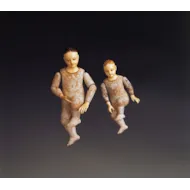Two Carved Ivory and Wood Figures from a religious tableau
Two Carved Ivory and Wood Figures from a religious tableau , Philippines . Ivory heads , hands and feet mounted on jointed lightwood ‘Bastidor’ bodies . Glass eyes , traces of paint and gesso , wigs and dress missing
Mid 19 th century
Size : 30.5 cm high , 13 cm wide – 12 ins high , 5 ins wide
23 cm high , 10 cm wide – 9 ins high , 4 ins wide
Mid 19 th century
Size : 30.5 cm high , 13 cm wide – 12 ins high , 5 ins wide
23 cm high , 10 cm wide – 9 ins high , 4 ins wide
The carving of ivory in the Philippines developed from the cultures of Goa , India , China , Spain and Portugal . Based on 16 th and 17 th century Spanish accounts the Filipinos carved three types of ivory article : religious statuary , jewellery and dagger hilts . There was no tradition of ivory carving before the coming of the Spanish and as they established the new colony in the mid 16 th century Chinese traders began to come in increasing numbers .
By 1581 there was a large community of Chinese in Manila and by the 1590's ivory carving among the local Chinese had already become a sophisticated art . There existed a large demand for ivory 'Santos' in the Philippines , certainly more than existed in Macau , and many of the Chinese Christian ivory images once thought to have been carved in China are most probably from Manila .
'Bastidor' means frame and these figures of various sizes were made to be clothed in garments of silk , cloth of gold or even meticulously chased and cut sheets of silver and gold . They were finished with crowns , earrings , rosaries , crucifixes and halo's all made of precious metal often set with stones . Like overdressed dolls , these Santos were given wigs , the hair for which is reputed to have come from the tresses of women who had taken their final vows before entering the nunnery .
By 1581 there was a large community of Chinese in Manila and by the 1590's ivory carving among the local Chinese had already become a sophisticated art . There existed a large demand for ivory 'Santos' in the Philippines , certainly more than existed in Macau , and many of the Chinese Christian ivory images once thought to have been carved in China are most probably from Manila .
'Bastidor' means frame and these figures of various sizes were made to be clothed in garments of silk , cloth of gold or even meticulously chased and cut sheets of silver and gold . They were finished with crowns , earrings , rosaries , crucifixes and halo's all made of precious metal often set with stones . Like overdressed dolls , these Santos were given wigs , the hair for which is reputed to have come from the tresses of women who had taken their final vows before entering the nunnery .
Two Carved Ivory and Wood Figures from a religious tableau

SOLD



